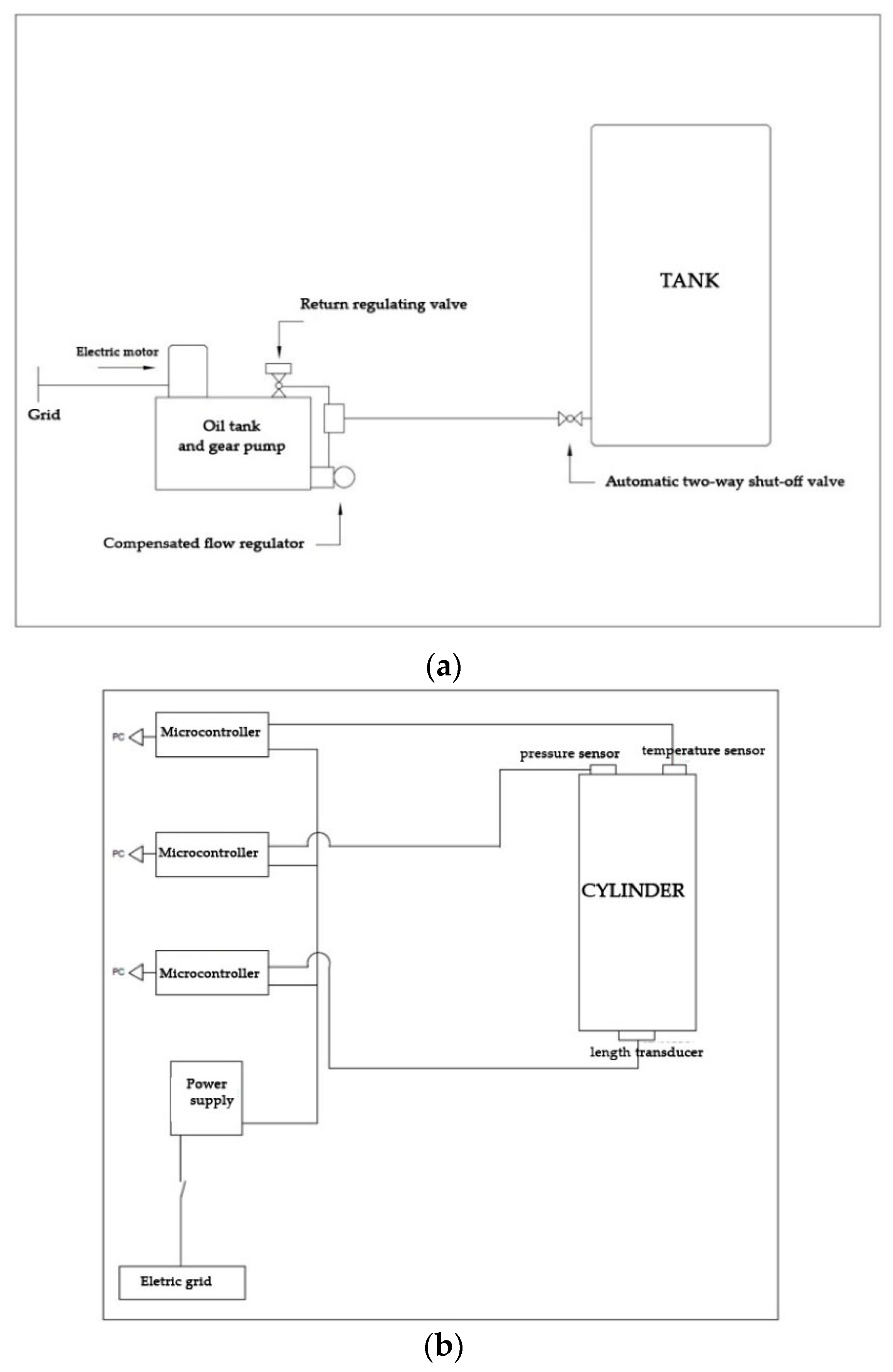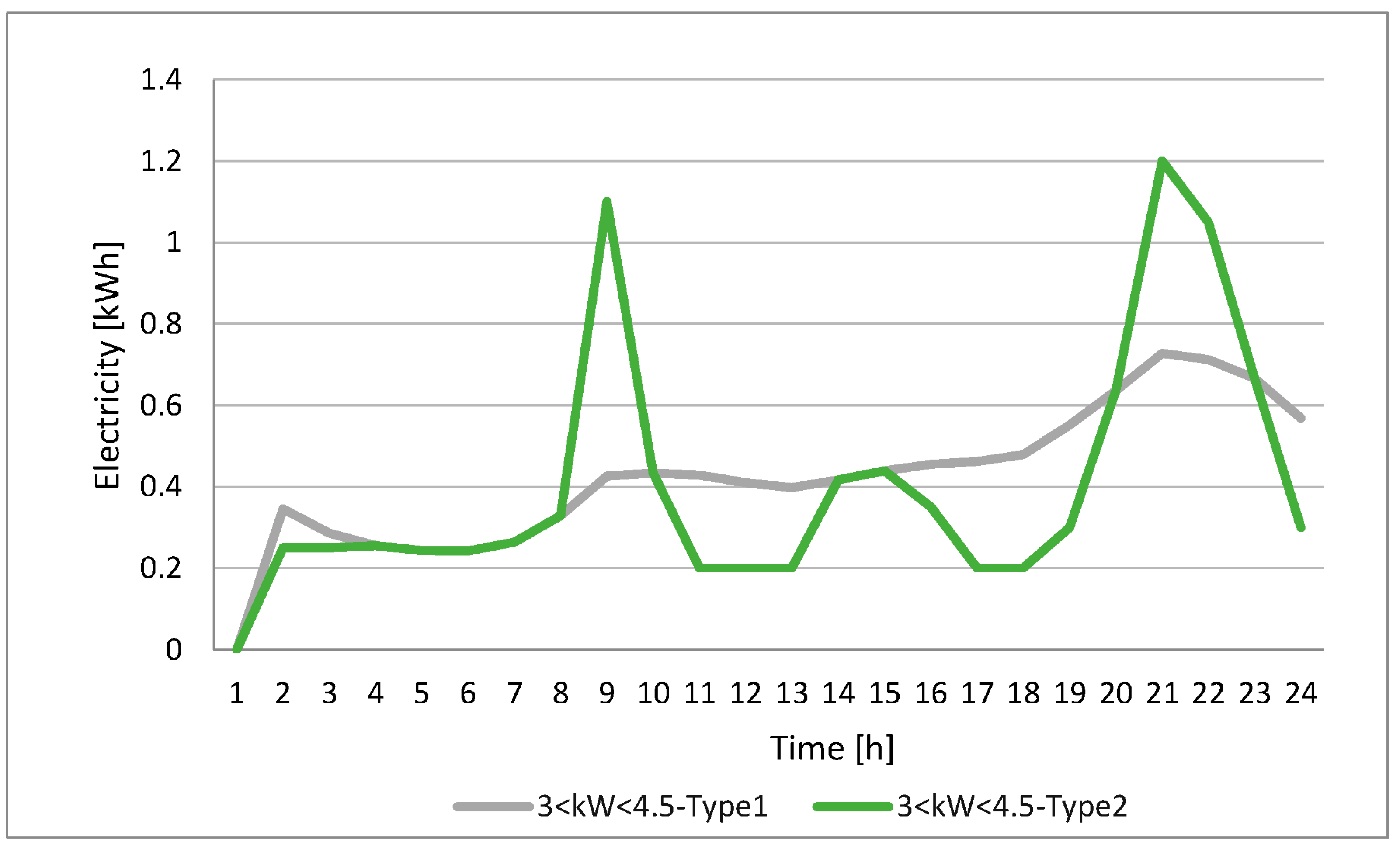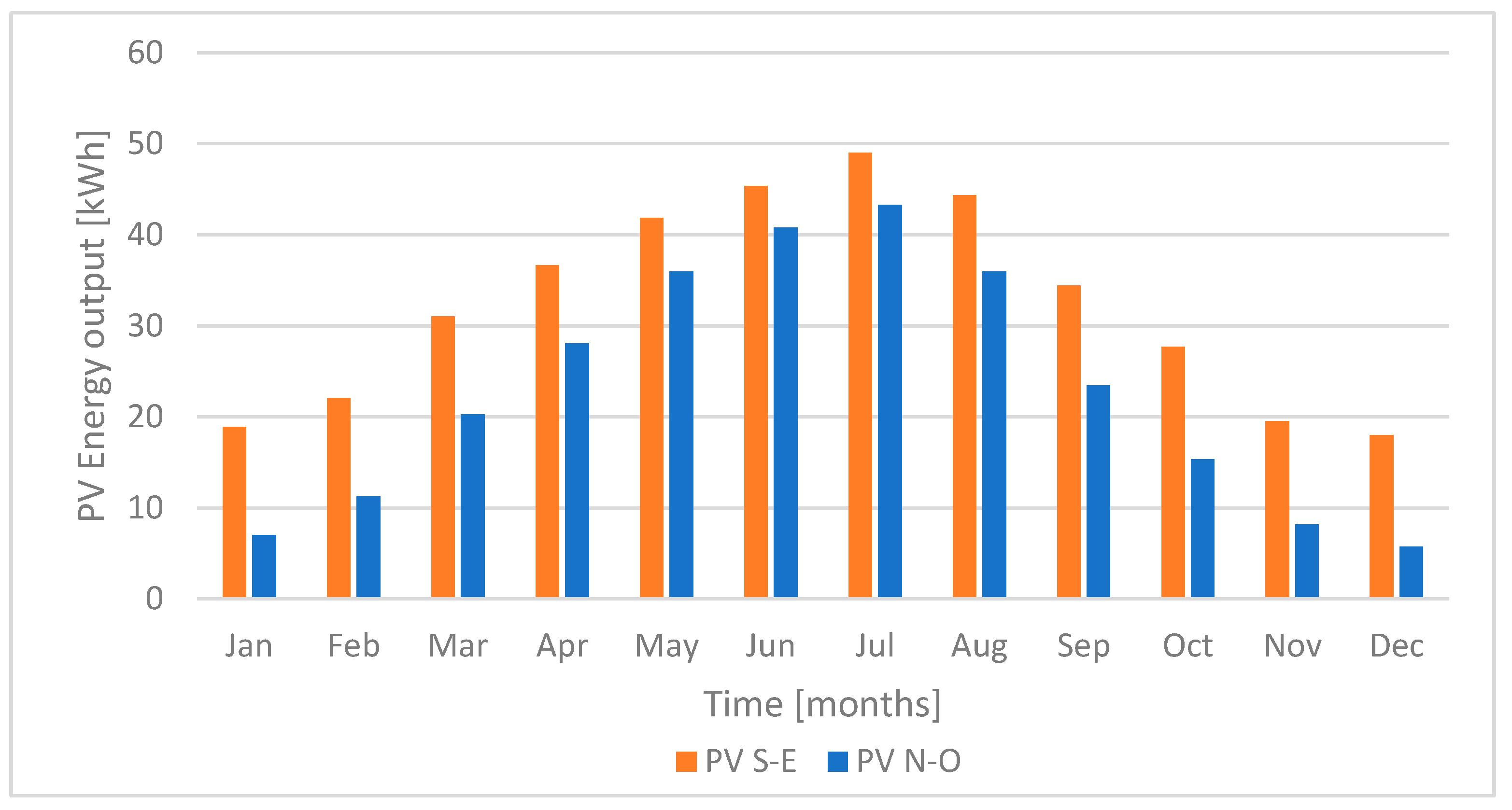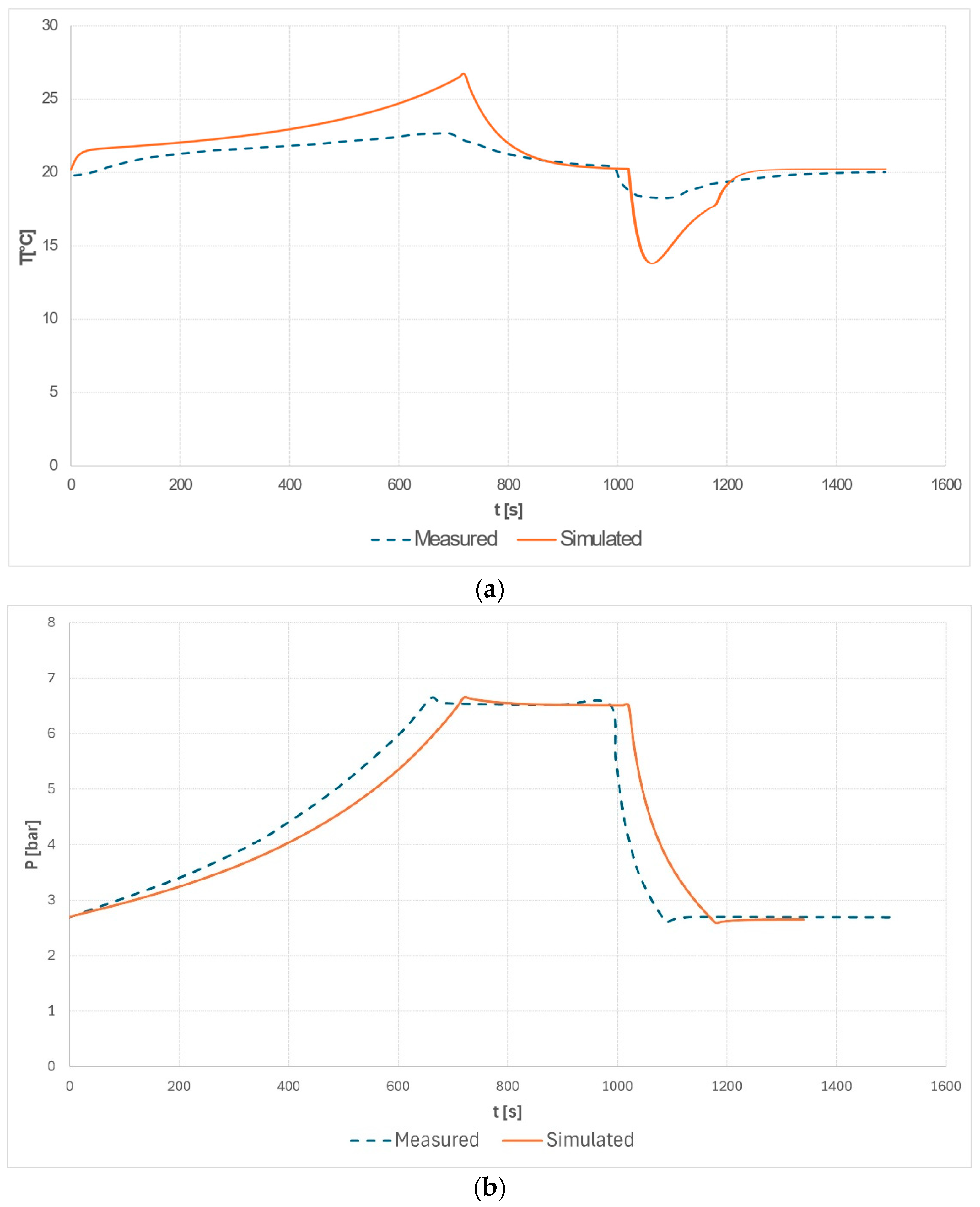Mitigation of Renewable Energy Source Production Variability in Residential Stock through Small-Scale Gas–Liquid Energy Storage Technology Application
Abstract
:1. Introduction
2. Materials and Methods
2.1. Gas–Liquid Energy Storage Prototype and Measurement Setup
- Pre-charging phase: the nitrogen pressure is brought to an initial pre-pressurization value of 2.65 bar, acting on the inlet placed on the device head, then the oil is made to flow inside the cylinder until it reaches the desired final pressure value, determined via reference to three pressure ratio (CR) values: 1.5, 2, and 2.5. Each of them is obtained by varying the flow of the inlet oil through a knob present in the compensated flow regulator placed in cascade to the pump.
- Stabilization pause: after reaching the final pressure, a five-minute break is taken. This time is used to allow the values of the various measured quantities (such as pressure and temperature) to stabilize.
- Discharge phase: the discharge phase is started by opening the outflow valve. This phase is maintained until the initial value of oil contained inside the cylinder is reached, which is the same as before the charging phase (equal to 0.2 liters).
- Final Pause: after the discharging phase, a further pause of five minutes is taken to return all the values to the initial levels.
2.2. Thermodynamic Model
- Gas behaves like a perfect gas;
- The temperature of the external environment is constant;
- The thermophysical properties of the cylinder material are constant over time;
- The temperature gradient is zero for each element in each direction;
- Processes occur at a near-steady state.
2.3. PV-GLES Coupling for Building Application/Application of PV-GLES Coupling in a Case Study Building
3. Results
3.1. Experimental Results and Model Validation
3.2. Thermodynamic Performance
4. Discussion
5. Conclusions
- The simulated temperature trend differences from experimental results should be reduced, particularly during the discharge phase. The charging phase shows a faster temperature rise, settling relatively close to real values but diverging by 13% at the compression end.
- Smaller variations occur in simulations, with a delay of about 10 s in reaching peak pressure during charging and returning to initial pressure during discharging due to the chosen temporal discretization step.
- Higher compression ratios (p*) led to a greater maximum temperature (Tmax) reached by the gas during pressure increase: the Tmax increased by 19% as p* triplicated.
- Simulations starting from the same pressure exhibited overlapping curves; however, starting from a higher pressure (curve B, 100 bar) meant that the maximum temperature was reached faster (20 s) and it took longer (38 s) to return to the initial volume.
- The gas–liquid storage units required to meet domestic needs were 175 (energy density (ED) of 1.4107 kWh/m3, volume 0.25 m3), requiring a surface area of 22.70 m2 for installation; the same storage capacity can be met by 50 lead–acid batteries (12 V, 200 Ah, commercial dimensions), for which must be reserved a total volume of 1.49 m3.
- The lower energy efficiency of the GLES system in comparison to electrochemical energy storage can be attributed to the pressure ramps that it operates within.
Author Contributions
Funding
Data Availability Statement
Conflicts of Interest
Nomenclature
| Abbreviations | |
| GLES | Gas–liquid energy storage |
| RES | Renewable energy source |
| CAES | Compressed-air energy storage |
| GLIDES | Ground-Level Integrated Diverse Energy Storage |
| ORNL | Oak Ridge National Laboratory |
| PV | Photovoltaic array |
| PV-GIS | Photovoltaic array –geographical information system |
| Symbols | |
| Mass flow rate [kg/s] | |
| ED | Energy density [kWh/m3] |
| Heat transfer coefficient [W/m2 K] | |
| RTE | Roundtrip efficiency [-] |
| Height [m] | |
| Lcompr | Compression work [J] |
| Lelect,in | Total electrical work required [J] |
| Lelect,out | Total electrical work provided [J] |
| Expansion work [J] | |
| Temperature [K] | |
| Maximum temperature [K] | |
| Volume [m3] | |
| Empty storage volume [m3] | |
| Specific heat capacity [J/kg K] | |
| Mass [kg] | |
| Pressure [Pa] | |
| p* | Compression ratio [-] |
| Time [s] | |
| Thermal transmittance [W/m2 K] | |
| ηM−P | Motor–pump efficiency [-] |
| ηT−G | Turbine–generator efficiency [-] |
| ηind | Indicated efficiency [-] |
| Subscripts | |
| Average | |
| Base | |
| External | |
| Gas | |
| Internal | |
| Oil | |
| External environment | |
| Piston | |
| Real | |
| Total | |
| Simulated | |
| Tank | |
| At constant volume | |
References
- Cui, F.; An, D.; Teng, S.; Lin, X.; Li, D.; Xi, H. Cogeneration Systems of Solar Energy Integrated with Compressed Air Energy Storage Systems: A Comparative Study of Various Energy Recovery Strategies. Case Stud. Therm. Eng. 2023, 51, 103521. [Google Scholar] [CrossRef]
- Mirnaghi, M.S.; Haghighat, F. Fault Detection and Diagnosis of Large-Scale HVAC Systems in Buildings Using Data-Driven Methods: A Comprehensive Review. Energy Build. 2020, 229, 110492. [Google Scholar] [CrossRef]
- Nardecchia, F.; Pompei, L.; Bisegna, F. Environmental Parameters Assessment of a New Diffuser for Air Cooling/Heating System: Measurements and Numerical Validation. Build. Simul. 2022, 15, 1111–1132. [Google Scholar] [CrossRef]
- Cuesta-Fernández, I.; Vargas-Salgado, C.; Alfonso-Solar, D.; Gómez-Navarro, T. The Contribution of Metropolitan Areas to Decarbonize the Residential Stock in Mediterranean Cities: A GIS-Based Assessment of Rooftop PV Potential in Valencia, Spain. Sustain. Cities Soc. 2023, 97, 104727. [Google Scholar] [CrossRef]
- Chen, L.; Huang, L.; Hua, J.; Chen, Z.; Wei, L.; Osman, A.I.; Fawzy, S.; Rooney, D.W.; Dong, L.; Yap, P.S. Green Construction for Low-Carbon Cities: A Review. Environ. Chem. Lett. 2023, 21, 1627–1657. [Google Scholar] [CrossRef]
- Alirahmi, S.M.; Razmi, A.R.; Arabkoohsar, A. Comprehensive Assessment and Multi-Objective Optimization of a Green Concept Based on a Combination of Hydrogen and Compressed Air Energy Storage (CAES) Systems. Renew. Sustain. Energy Rev. 2021, 142, 110850. [Google Scholar] [CrossRef]
- Babaei, S.M.; Nabat, M.H.; Lashgari, F.; Pedram, M.Z.; Arabkoohsar, A. Thermodynamic Analysis and Optimization of an Innovative Hybrid Multi-Generating Liquid Air Energy Storage System. J. Energy Storage 2021, 43, 103262. [Google Scholar] [CrossRef]
- Pompei, L.; Nardecchia, F.; Miliozzi, A. Current, Projected Performance and Costs of Thermal Energy Storage. Processes 2023, 11, 729. [Google Scholar] [CrossRef]
- Li, B.; Liu, Z.; Wu, Y.; Wang, P.; Liu, R.; Zhang, L. Review on Photovoltaic with Battery Energy Storage System for Power Supply to Buildings: Challenges and Opportunities. J. Energy Storage 2023, 61, 106763. [Google Scholar] [CrossRef]
- Rekioua, D. Energy Storage Systems for Photovoltaic and Wind Systems: A Review. Energies 2023, 16, 3893. [Google Scholar] [CrossRef]
- Zeynalian, M.; Hajialirezaei, A.H.; Razmi, A.R.; Torabi, M. Carbon Dioxide Capture from Compressed Air Energy Storage System. Appl. Therm. Eng. 2020, 178, 115593. [Google Scholar] [CrossRef]
- Vallati, A.; Fiorini, C.V.; Lo Basso, G.; Muzi, F.; Oclon, P.; Di Matteo, M. Optimization of a Thermal Storage Tank for a Water Water Heat Pump Solar Assited. In Proceedings of the 2023 8th International Conference on Smart and Sustainable Technologies, SpliTech 2023, Bol, Croatia, 20–23 June 2023; Institute of Electrical and Electronics Engineers Inc.: Piscataway, NJ, USA, 2023. [Google Scholar]
- Razmi, A.R.; Hanifi, A.R.; Shahbakhti, M. Design, Thermodynamic, and Economic Analyses of a Green Hydrogen Storage Concept Based on Solid Oxide Electrolyzer/Fuel Cells and Heliostat Solar Field. Renew. Energy 2023, 215, 118996. [Google Scholar] [CrossRef]
- Nabat, M.H.; Habibzadeh, M.; Alsagri, A.S.; Arabkoohsar, A. An Investigation and Multi-Criteria Optimization of an Innovative Compressed Air Energy Storage. J. Energy Storage 2024, 76, 109645. [Google Scholar] [CrossRef]
- Razmi, A.; Soltani, M.; Torabi, M. Investigation of an Efficient and Environmentally-Friendly CCHP System Based on CAES, ORC and Compression-Absorption Refrigeration Cycle: Energy and Exergy Analysis. Energy Convers. Manag. 2019, 195, 1199–1211. [Google Scholar] [CrossRef]
- Adib, M.; Nasiri, F.; Haghighat, F. Integrating Wind Energy and Compressed Air Energy Storage for Remote Communities: A Bi-Level Programming Approach. J. Energy Storage 2023, 72, 108496. [Google Scholar] [CrossRef]
- Minutillo, M.; Lubrano Lavadera, A.; Jannelli, E. Assessment of Design and Operating Parameters for a Small Compressed Air Energy Storage System Integrated with a Stand-Alone Renewable Power Plant. J. Energy Storage 2015, 4, 135–144. [Google Scholar] [CrossRef]
- Wang, Z.; Ting, D.S.K.; Carriveau, R.; Xiong, W.; Wang, Z. Design and Thermodynamic Analysis of a Multi-Level Underwater Compressed Air Energy Storage System. J. Energy Storage 2016, 5, 203–211. [Google Scholar] [CrossRef]
- Facci, A.L.; Sánchez, D.; Jannelli, E.; Ubertini, S. Trigenerative Micro Compressed Air Energy Storage: Concept and Thermodynamic Assessment. Appl. Energy 2015, 158, 243–254. [Google Scholar] [CrossRef]
- Heidari, M.; Mortazavi, M.; Rufer, A. Design, Modeling and Experimental Validation of a Novel Finned Reciprocating Compressor for Isothermal Compressed Air Energy Storage Applications. Energy 2017, 140, 1252–1266. [Google Scholar] [CrossRef]
- Bazdar, E.; Nasiri, F.; Haghighat, F. An Improved Energy Management Operation Strategy for Integrating Adiabatic Compressed Air Energy Storage with Renewables in Decentralized Applications. Energy Convers. Manag. 2023, 286, 117027. [Google Scholar] [CrossRef]
- Budt, M.; Wolf, D.; Span, R.; Yan, J. A Review on Compressed Air Energy Storage: Basic Principles, Past Milestones and Recent Developments. Appl. Energy 2016, 170, 250–268. [Google Scholar] [CrossRef]
- Venkataramani, G.; Vijayamithran, P.; Li, Y.; Ding, Y.; Chen, H.; Ramalingam, V. Thermodynamic Analysis on Compressed Air Energy Storage Augmenting Power/Polygeneration for Roundtrip Efficiency Enhancement. Energy 2019, 180, 107–120. [Google Scholar] [CrossRef]
- Odukomaiya, A.; Abu-Heiba, A.; Gluesenkamp, K.R.; Abdelaziz, O.; Jackson, R.K.; Daniel, C.; Graham, S.; Momen, A.M. Thermal Analysis of Near-Isothermal Compressed Gas Energy Storage System. Appl. Energy 2016, 179, 948–960. [Google Scholar] [CrossRef]
- Mozayeni, H.; Wang, X.; Negnevitsky, M. Thermodynamic and Exergy Analysis of a Combined Pumped Hydro and Compressed Air Energy Storage System. Sustain. Cities Soc. 2019, 48, 101527. [Google Scholar] [CrossRef]
- Kassaee, S.; Abu-Heiba, A.; Ally, M.R.; Mench, M.M.; Liu, X.; Odukomaiya, A.; Chen, Y.; King, T.J.; Smith, B.T.; Momen, A.M. PART 1- Techno-Economic Analysis of a Grid Scale Ground-Level Integrated Diverse Energy Storage (GLIDES) Technology. J. Energy Storage 2019, 25, 100792. [Google Scholar] [CrossRef]
- Odukomaiya, A.; Abu-Heiba, A.; Graham, S.; Momen, A.M. Experimental and Analytical Evaluation of a Hydro-Pneumatic Compressed-Air Ground-Level Integrated Diverse Energy Storage (GLIDES) System. Appl. Energy 2018, 221, 75–85. [Google Scholar] [CrossRef]
- Ko, J.; Kim, S.; Kim, S.; Seo, H. Utilizing Building Foundations as Micro-Scale Compressed Air Energy Storage Vessel: Numerical Study for Mechanical Feasibility. J. Energy Storage 2020, 28, 101225. [Google Scholar] [CrossRef]
- Patil, V.C.; Ro, P.I. Modeling of Liquid-Piston Based Design for Isothermal Ocean Compressed Air Energy Storage System. J. Energy Storage 2020, 31, 101449. [Google Scholar] [CrossRef]
- Chatzivasileiadi, A.; Ampatzi, E.; Knight, I. Characteristics of Electrical Energy Storage Technologies and Their Applications in Buildings. Renew. Sustain. Energy Rev. 2013, 25, 814–830. [Google Scholar] [CrossRef]
- Mahlia, T.M.I.; Saktisahdan, T.J.; Jannifar, A.; Hasan, M.H.; Matseelar, H.S.C. A Review of Available Methods and Development on Energy Storage; Technology Update. Renew. Sustain. Energy Rev. 2014, 33, 532–545. [Google Scholar] [CrossRef]
- Lisbona, D.; Snee, T. A Review of Hazards Associated with Primary Lithium and Lithium-Ion Batteries. Process Saf. Environ. Prot. 2011, 89, 434–442. [Google Scholar] [CrossRef]
- Vallati, A.; de Lieto Vollaro, R.; Oclon, P.; Taler, J. Experimental and Analytical Evaluation of a Gas-Liquid Energy Storage (GLES) Prototype. Energy 2021, 224, 120061. [Google Scholar] [CrossRef]
- Castellani, B.; Morini, E.; Nastasi, B.; Nicolini, A.; Rossi, F. Small-Scale Compressed Air Energy Storage Application for Renewable Energy Integration in a Listed Building. Energies 2018, 11, 1921. [Google Scholar] [CrossRef]








| Measurement | Probe | Measuring Range | Accuracy |
|---|---|---|---|
| Gas temperature | IFM TT1250 Pt1000 class A RTD Thermometer (Monza, Italy) | −40 °C–>150 °C | ±(0.15 K + 0.002|𝑇|) |
| Gas temperature | IFM TP9237 amplifier for temperature probes (Monza, Italy) | −50 °C–>300 °C | ±0.4% |
| Gas pressure | Fox TR41/M3 Pressure transducer (Milan, Italy) | 0–10 bar | <1% of full scale |
| Gas pressure | AFRISO RF63GlyD701 Pressure gauge (Güglingen, Germany) | 0–>16 bar | Accuracy class 1.6 |
| Gas volume (through length) | Siko SGH10 length transducer (Buchenbach, Germany) | 4–20 mA | |
| Oil temperature | IFM TT1250 Pt1000 class A RTD Thermometer (Monza, Italy) | −40 °C–>150 °C | ±(0.15 K + 0.002|𝑇|) |
| Parameter | |
|---|---|
| Oil mass. | moil |
| Gas mass | mgas |
| Inlet flow oil | in, oil |
| Discharge oil flow rate | out, oil |
| Pressure | Pgas |
| Outdoor temperature | Tout |
| Gas temperature | Tgas |
| Oil temperature | Toil |
| Tank temperature in contact with gas | Tgas, tank |
| Tank temperature in contact with oil | Toil, tank |
| Parameter | Final Pressure 4 Bar | Final Pressure 5.3 Bar | Final Pressure 6.6 Bar | |||
|---|---|---|---|---|---|---|
| Charge Phase | Discharge Phase | Charge Phase | Discharge Phase | Charge Phase | Discharge Phase | |
| Time (s) | 326.2 | 56 | 524.8 | 83.4 | 664 | 100.4 |
| Initial pressure (bar) | 2.70 | 3.92 | 2.69 | 5.17 | 2.7 | 6.43 |
| Final pressure (bar) | 4.00 | 2.61 | 5.31 | 2.61 | 6.62 | 2.61 |
| Initial temperature (K) | 293.35 | 293.65 | 293.25 | 293.65 | 292.95 | 293.55 |
| Final temperature (K) | 295.15 | 292.65 | 295.65 | 291.95 | 295.85 | 291.45 |
| Initial volume (L) | 0.1 | 5.4 | 0.1 | 8.6 | 0.1 | 10.7 |
| Final volume (L) | 5.4 | 0.1 | 8.6 | 0.1 | 10.7 | 0.1 |
| Oil flow rate (L/min) | 1 | 5.3 | 1 | 5.3 | 1 | 5.3 |
| RTE | 79.38% | 68.71% | 67.80% | |||
| ED | 0.019 kWh/m3 | 0.035 kWh/m3 | 0.048 kWh/m3 | |||
| Pmin [bar] | Pmax [bar] | L elect,in [J] | L elect,out [J] | RTE [kWh/m3] | ED [kWh/m3] | |
|---|---|---|---|---|---|---|
| Measured | 70 | 130 | 5.81 × 103 | 4.05 × 103 | 0.6974 | 0.0547 |
| Simulated | 5263.84 | 3569.36 | 0.6780 | 0.0480 |
| ID | Pmin [Bar] | Pmax [Bar] | Lelect,in [J] | Lelect,in_kWh [kWh] | Lelect,out [J] | Lelect,out_kWh [kWh] | RTE [kWh/m3] | ED [kWh/m3] |
|---|---|---|---|---|---|---|---|---|
| Case 1 | 70 | 130 | 1.11 × 106 | 0.3088 | 7.56 × 105 | 0.2103 | 0.6808 | 0.8712 |
| Case 2 | 70 | 100 | 6.16 × 105 | 0.1713 | 4.30 × 105 | 0.1195 | 0.6972 | 0.495 |
| Case 3 | 100 | 130 | 6.18 × 105 | 0.1718 | 4.40 × 105 | 0.1224 | 0.712 | 0.507 |
| Case 4 | 50 | 200 | 1.88 × 106 | 0.5237 | 1.22 × 106 | 0.3405 | 0.6501 | 1.4107 |
Disclaimer/Publisher’s Note: The statements, opinions and data contained in all publications are solely those of the individual author(s) and contributor(s) and not of MDPI and/or the editor(s). MDPI and/or the editor(s) disclaim responsibility for any injury to people or property resulting from any ideas, methods, instructions or products referred to in the content. |
© 2024 by the authors. Licensee MDPI, Basel, Switzerland. This article is an open access article distributed under the terms and conditions of the Creative Commons Attribution (CC BY) license (https://creativecommons.org/licenses/by/4.0/).
Share and Cite
Vallati, A.; Di Matteo, M.; Pompei, L.; Nardecchia, F.; Fiorini, C.V. Mitigation of Renewable Energy Source Production Variability in Residential Stock through Small-Scale Gas–Liquid Energy Storage Technology Application. Processes 2024, 12, 655. https://doi.org/10.3390/pr12040655
Vallati A, Di Matteo M, Pompei L, Nardecchia F, Fiorini CV. Mitigation of Renewable Energy Source Production Variability in Residential Stock through Small-Scale Gas–Liquid Energy Storage Technology Application. Processes. 2024; 12(4):655. https://doi.org/10.3390/pr12040655
Chicago/Turabian StyleVallati, Andrea, Miriam Di Matteo, Laura Pompei, Fabio Nardecchia, and Costanza Vittoria Fiorini. 2024. "Mitigation of Renewable Energy Source Production Variability in Residential Stock through Small-Scale Gas–Liquid Energy Storage Technology Application" Processes 12, no. 4: 655. https://doi.org/10.3390/pr12040655
APA StyleVallati, A., Di Matteo, M., Pompei, L., Nardecchia, F., & Fiorini, C. V. (2024). Mitigation of Renewable Energy Source Production Variability in Residential Stock through Small-Scale Gas–Liquid Energy Storage Technology Application. Processes, 12(4), 655. https://doi.org/10.3390/pr12040655











